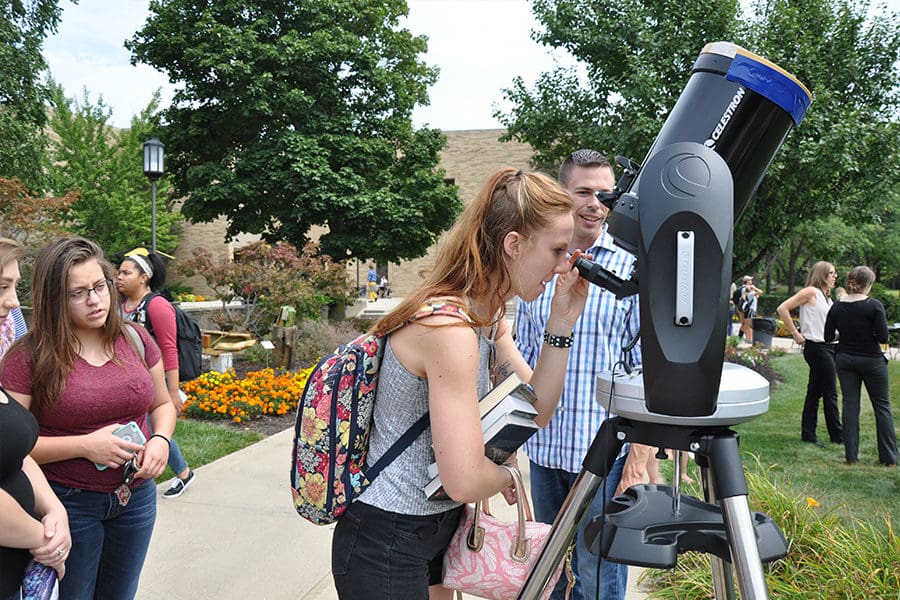Research
Chemistry and physics department faculty are engaged in research in a variety of sub-fields in chemistry, physics and astronomy.
Areas of emphasis include drug discovery, environmental and computational chemistry, biochemistry, analytical chemistry, astronomy, experimental high energy physics, and high energy astrophysics.

Center for High Energy Physics
Our group uses the world’s highest-energy particle accelerators and advanced detectors to study the fundamental particles that make up our universe.
Faculty Research
At Purdue University Northwest, faculty are encouraged to pursue research actively as part of their regular work activity. Our faculty members are experts in a wide range of fields. Below are the research areas of the department.
Analytical chemistry is concerned with identifying and quantifying amounts of substances in compounds. The Department houses modern analytical instruments such as GC-MS, HPLC, FTIR, AAS, and NMR which serve as the core of the major instrumentation facility needed for analytical and other chemical and biochemical research. These instruments are essential tools in the research on food safety and biomarkers conducted by Dr. Dawit Gizachew.
Biochemistry is the study of compounds and reactions involving living organisms. Several of our faculty are involved in studying bimolecular modeling & synthesis, drug design, and pathways for treating cancer, kidney disease, Alzheimer’s disease, etc. Faculty members who work in these areas are Dr. Meden Isaac-Lam and Dr. Farai Gombedza.
Dr. Gombedza also studies the molecular mechanism of signal transduction in diseases including allergic asthma, vaping-induced lung diseases and kidney diseases.
The research interests of Dr. Libbie Pelter and Dr. Michael Pelter are in the area of catalysis chemistry and polymers. The study of polymers deals with the creation of new materials, while chemical catalysis deals with reactants, catalysts and their interplay to study and determine the overall outcome of a reaction.
The Department prides itself as a leader in pedagogical research in chemistry and physics. In addition to conducting fundamental research in their fields of interest, many faculty members are interested in the scholarship of teaching and learning. They use the classroom as a laboratory and conduct research to improve undergraduate education. Dr. Aaron Warren, Dr. Farai Gombedza, Dr. Meden Isaac-Lam, and Dr. Michael Pelter have contributed to this area of research.
Dr. Kay Rowberg uses computational chemistry techniques to predict chemical toxicity based on the physicochemical features of molecules. This work is largely computational and quick, and, therefore, is extremely useful in predicting toxicity or activity before in vivo testing. Her recent research endeavor is to provide physical and chemical characterization of objects of art and historic artifacts. She has also used nondestructive methods (spectroscopy and a paper test) to provide evidence of authentication.
Environmental chemistry research involves substances that affect the quality of our environment. Dr. Rey Barreto and Dr. Kay Rowberg conduct research in this area. Dr. Barreto’s research is focused on the degradation of pharmaceutical contaminants in water supply systems by photocatalytic techniques and Dr. Roberg’s research emphasizes the collection and analysis of aquatic samples for toxicity levels.
Dr. Glynn E. Bricker studies Early Solar System Evolution. Dr. Bricker’s research is an attempt to constrain early solar system evolution with samples of meteorites from the time the solar system was forming.
Dr. Adam Rengstorf has a research focus in Observational Astronomy. As the Director of the Northwest Indiana Robotic (NIRo) Observatory, he has mentored undergraduate students in NIRo research projects. They have been using the NIRo telescope to watch things in the sky that change in position and/or brightness over time – near-Earth asteroids and eclipsing binary star systems.
Our department is proud to have two well-known experimental high energy physicists on our faculty. Dr. Neeti Parahsar is the leader of the high energy physics program at Purdue University Northwest. She was a contributing author to the “Discovery of the Higgs Boson”, which validated the theory proposed by the 2013 Nobel Prize winners in Physics, Dr. Peter Higgs and Dr. Fancois Engleret. Her research activities are primarily performed at Fermilab located in Batavia, Illinois, and the European Center for Nuclear Research (CERN) in Geneva, Switzerland. At Fermilab, she collaborates on the DZERO (“Dee-Zero”) experiment, while at CERN she works on the Compact Muon Solenoid (CMS) experiment.
Dr. James Dolen primarily works at the Fermilab conducting Particle Detector Upgrade and algorithms research on the CMS experiment. He has engaged physics students in his collaboration with Fermilab experiments. Their research is funded by the National Science Foundation.
Theoretical physics including computational physics and high energy astrophysics are areas of interest to Dr. Aaron Warren and Dr. Dan Suson.
Dr. Warren works with undergraduate students in numerical relativity, conducting simulations of binary compact object mergers involving neutron stars and black holes and resulting gravitational waves first detected in 2015. Dr. Warren’s simulations employ fully relativistic models of the gravitational and magnetohydrodynamic evolution of merging compact objects.
Dr. Suson’s research interests focus on theoretical astrophysics and physics pedagogy. He has been a member of the Fermi Gamma-Ray Space Telescope since 1994 and has worked with students on various simulation and data analysis projects relating to the telescope.
Purna Das’ interest lies in the area of Theoretical Solid State Physics and Chemical Physics. He is involved in theoretical investigations of the spectroscopic properties of adsorbed molecules on or near small metal particles and surfaces.
Dr. Robert Kramer studies energy systems and nuclear engineering analysis of nuclear reactors. His current research interests include energy efficiency and renewable energy sources. He has been a pioneer in Indiana in the assessment and optimization of new lighting technology for various communities.